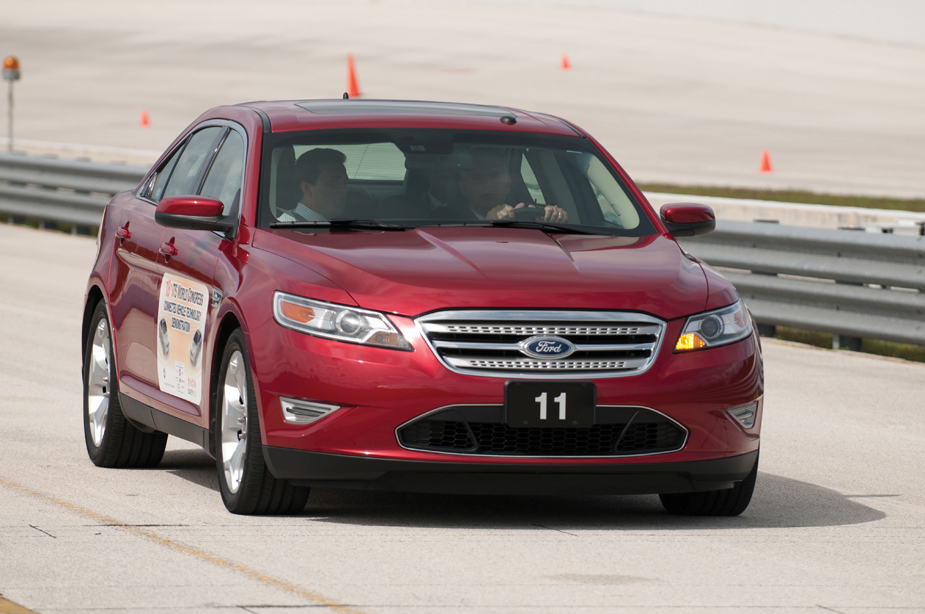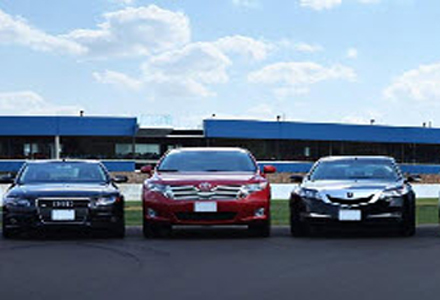Delegates at National Harbor this week have opportunity to gain first hand experience of a national connected vehicle program Vehicles of the test fleet of an extensive research program are being put through their paces each day of this year’s ITS America Annual Meeting. With the key objective of showing how vehicles from different manufacturers can communicate and understand each other, technology of the US DOT Connected Vehicle Safety Pilot Program is being demonstrated at National Harbor.

Delegates at National Harbor can experience the connected vehicle safety applications by registering to participate
Delegates at National Harbor this week have opportunity to gain first hand experience of a national connected vehicle program
Vehicles of the test fleet of an extensive research program are being put through their paces each day of this year’s ITS America Annual Meeting. With the key objective of showing how vehicles from different manufacturers can communicate and understand each other, technology of the US DOT Connected Vehicle Safety Pilot Program is being demonstrated at National Harbor. This program is part of a major concerted effort to develop vehicle to vehicle (V2V) and vehicle to infrastructure (V2I) communications, with the main aim of improving road safety. It is being developed through collaboration between a number of US DOT agencies, state transport departments and academic institutions, with the Crash Avoidance Metrics Partnership (CAMP) – a consortium of vehicle manufacturers. These include:278 Ford, 948 General Motors, Honda, 1684 Hyundai-5229 Kia, 1685 Mercedes-Benz, 838 Nissan, 1686 Toyota and 994 Volkswagen.
Technical development centres of each of these companies are involved through CAMP’s Vehicle Safety Communications 3 Consortium. Vehicles from each partner are also involved in one or more of the Safety Pilot applications: emergency electronic brake lights; forward collision warning; blind spot warning/lane change warning; do not pass warning; intersection movement assist; and left turn assist.
Delegates at National Harbor this week can ride in the vehicles to get a feel for the safety applications and test the different cars in various scenarios by registering to participate in the demonstrations.
About 600 people have already been treated to a similar experience, but under test conditions at a series of six connected vehicle ‘driver clinics’.
These were held between August 2011 and January this year at speedways or test sites in Brooklyn, MI, Brainerd, MN, Orlando, FL, Fort Worth TX, and Blacksburg and Alameda, VA.
Around 100 local drivers were recruited to drive 24 different cars under controlled conditions at each of the test sites. This was done to assess how drivers respond to the technology and how connected vehicles communicate. Road layouts and intersections were simulated at the six test sites. At no time does the connected vehicle system take control of the car; it only alerts drivers to impending hazards. A further key goal of the driver clinics was to investigate the best or most effective ways of relaying hazard alert messages – such as by means of an urgent tone augmented with flashing red lights in a head-up display, as is currently being developed by Ford Product Development.
Use of verbal warnings or text messages on display panels is thought to be impractical due to language and safety issues. The experts are agreed on the need for alerts to be universally understood without requiring drivers to take their eyes off the road. How best to do that has yet to be decided by the CAMP research partners. Before then, phase two of the Safety Pilot program is due to get under way in August 2012. This will involve a ‘safety pilot model deployment’ of V2V and V2I technology to be conducted by the Michigan Department of Transportation and the University of Michigan Transportation Research Institute. Around 3,000 vehicles, mostly government agency cars, trucks and buses, will be fitted with wireless communication devices and tracked during a year while using roadways in and around Ann Arbor in Michigan.
This element of the Safety Pilot will be used to test the DSRC (dedicated short range communication) technology and to study how effectively infrastructure can track and locate the vehicles. Ultimately, the program is building towards a national decision on whether to mandate V2V and V2I technology for all vehicles operating on US roads. The National Highways Traffic Safety Administration will study results from both phases of the Safety Pilot before making its decision – expected in 2013 for light vehicles and 2014 for heavy vehicles.
For registration details, visit:
%$Linker:External 0 0 0 oLinkExternal www.v2vtechreview-washingtondc.com Register false http://www.v2vtechreview-washingtondc.com/ false false %>
Vehicles of the test fleet of an extensive research program are being put through their paces each day of this year’s ITS America Annual Meeting. With the key objective of showing how vehicles from different manufacturers can communicate and understand each other, technology of the US DOT Connected Vehicle Safety Pilot Program is being demonstrated at National Harbor. This program is part of a major concerted effort to develop vehicle to vehicle (V2V) and vehicle to infrastructure (V2I) communications, with the main aim of improving road safety. It is being developed through collaboration between a number of US DOT agencies, state transport departments and academic institutions, with the Crash Avoidance Metrics Partnership (CAMP) – a consortium of vehicle manufacturers. These include:
Technical development centres of each of these companies are involved through CAMP’s Vehicle Safety Communications 3 Consortium. Vehicles from each partner are also involved in one or more of the Safety Pilot applications: emergency electronic brake lights; forward collision warning; blind spot warning/lane change warning; do not pass warning; intersection movement assist; and left turn assist.
Delegates at National Harbor this week can ride in the vehicles to get a feel for the safety applications and test the different cars in various scenarios by registering to participate in the demonstrations.
About 600 people have already been treated to a similar experience, but under test conditions at a series of six connected vehicle ‘driver clinics’.
These were held between August 2011 and January this year at speedways or test sites in Brooklyn, MI, Brainerd, MN, Orlando, FL, Fort Worth TX, and Blacksburg and Alameda, VA.
Around 100 local drivers were recruited to drive 24 different cars under controlled conditions at each of the test sites. This was done to assess how drivers respond to the technology and how connected vehicles communicate. Road layouts and intersections were simulated at the six test sites. At no time does the connected vehicle system take control of the car; it only alerts drivers to impending hazards. A further key goal of the driver clinics was to investigate the best or most effective ways of relaying hazard alert messages – such as by means of an urgent tone augmented with flashing red lights in a head-up display, as is currently being developed by Ford Product Development.
Use of verbal warnings or text messages on display panels is thought to be impractical due to language and safety issues. The experts are agreed on the need for alerts to be universally understood without requiring drivers to take their eyes off the road. How best to do that has yet to be decided by the CAMP research partners. Before then, phase two of the Safety Pilot program is due to get under way in August 2012. This will involve a ‘safety pilot model deployment’ of V2V and V2I technology to be conducted by the Michigan Department of Transportation and the University of Michigan Transportation Research Institute. Around 3,000 vehicles, mostly government agency cars, trucks and buses, will be fitted with wireless communication devices and tracked during a year while using roadways in and around Ann Arbor in Michigan.
This element of the Safety Pilot will be used to test the DSRC (dedicated short range communication) technology and to study how effectively infrastructure can track and locate the vehicles. Ultimately, the program is building towards a national decision on whether to mandate V2V and V2I technology for all vehicles operating on US roads. The National Highways Traffic Safety Administration will study results from both phases of the Safety Pilot before making its decision – expected in 2013 for light vehicles and 2014 for heavy vehicles.
For registration details, visit:
%$Linker:










